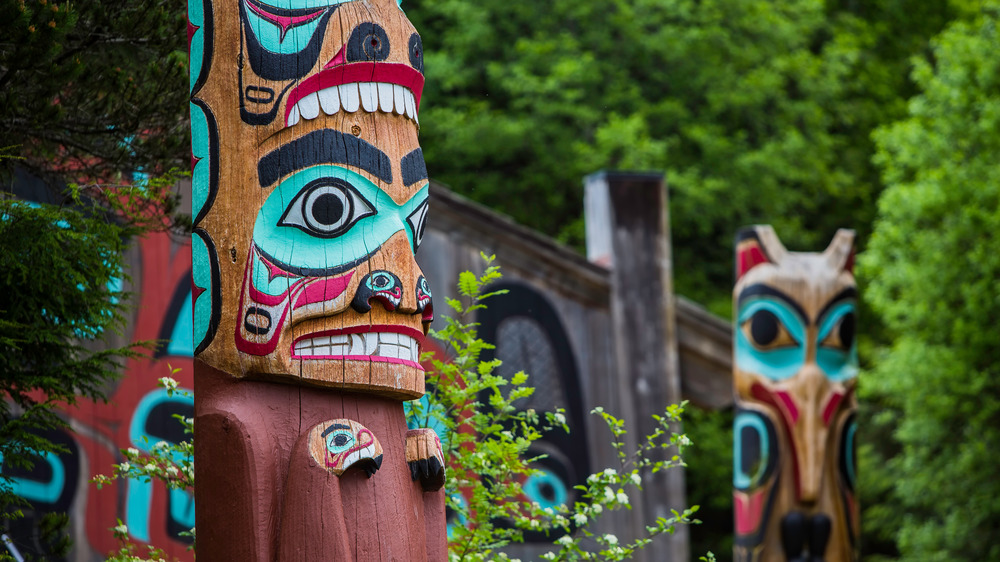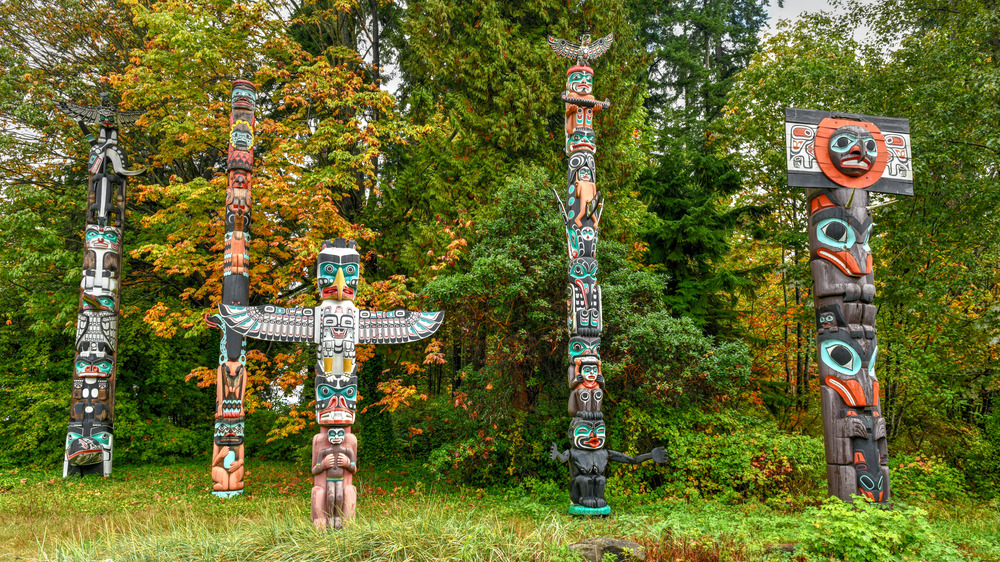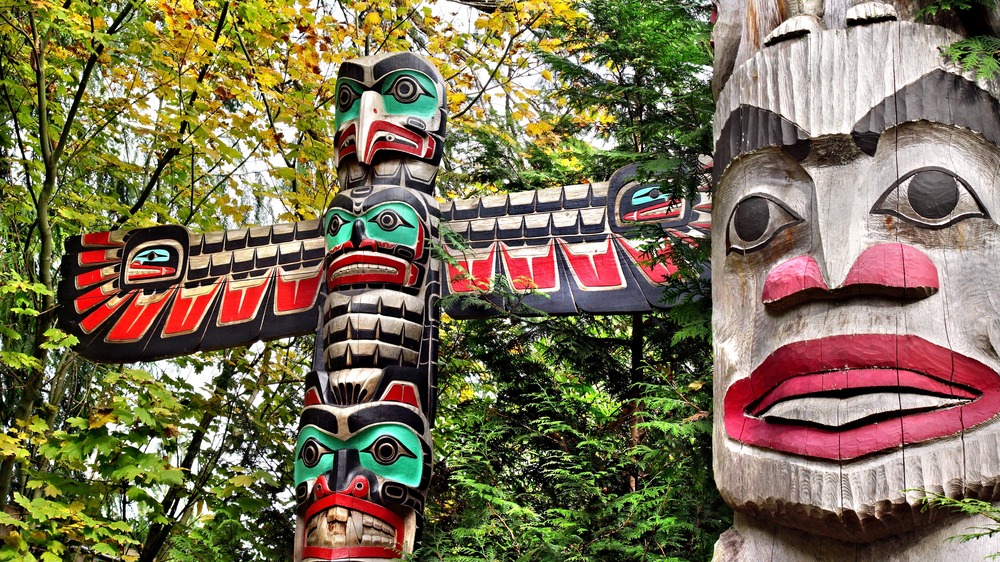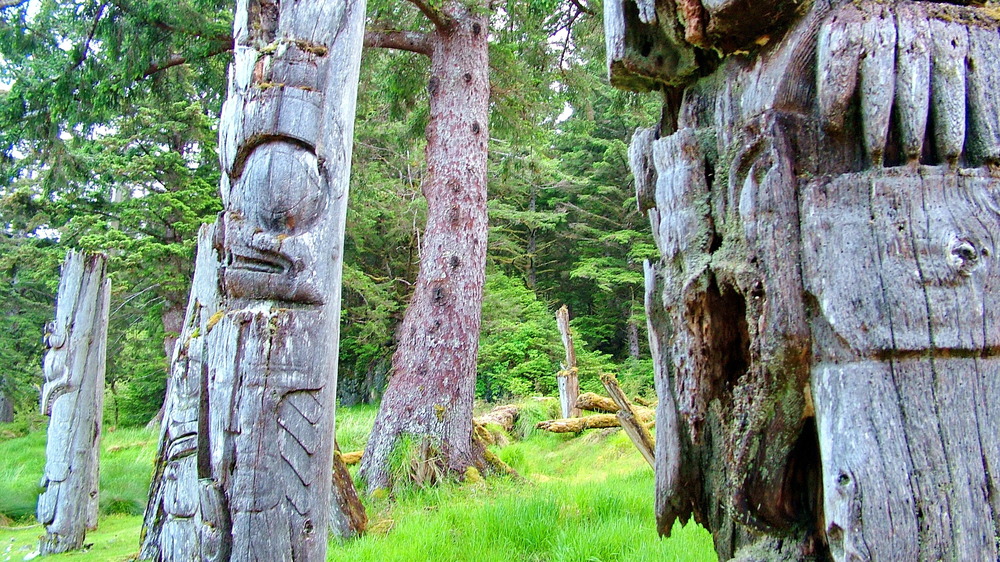The Fascinating History Of Totem Poles
Totem poles are easily one of the most recognizable cultural artifacts of indigenous peoples in the Pacific Northwest, whose ancestral territories encompass the strip of land from modern-day Alaska down through British Columbia. It may be surprising to some that totem poles originate in this area alone. In an article in the independent British Columbian magazine The Tyee, Aaron Glass, co-author of "The Totem Pole: An Intercultural History," says that they've come to be incorrectly lumped with other dated, stereotypically "Native American" paraphernalia, such as "the teepee, the tomahawk and the feathered headdress."
In reality, the practice of creating and carving totems poles belongs to a variety of First Nations people, the Canadian term for Aboriginal, non-Inuit and non-Métis peoples, per the First Nations & Indigenous People's studies program at the University of British Columbia (UBC), which developed the term as a respectful alternative to "Indian" in the 1970s and '80s. Predictably, understanding of totem poles has been mired by what another UBC article describes as "colonial efforts to Christianize and 'civilize' First Nations people" by banning, outlawing, stealing, assimilating — you name it — cultural practices, languages, or anything deemed "pagan," especially during the 19th century.
Thankfully, the artistic and spiritual practice of crafting totem poles has come into a clearer light as First Nations have continued to regain their rightful respect, and through individual, generational teachings such as that of Tain Guthrie in Metlakatla, Alaska, showing his son how to carve totems, as depicting in Scholastic.
Derived from an Ojibwe term describing 'kinship groups'
Totem poles have come a long way from being identified as "curiosities" or roadside kitsch sold to collectors and shipped off to far-flung countries. (As recently as the 1990s, the Haisla people of the Kitimat area succeeded in retrieving a totem pole stolen 80 years prior and sold to a Swedish museum).
The word totem has come to be used in modern English just like any other word, indicating an emblem or herald, much like a Scottish tartan. Totem is likely a derivative of the Ojibwe word doodem. That tribe spoke an Algonquin dialect and lived from the Great Lakes out through North Dakota. As the Minnesota Historical Society says, a doodem was a societal role: "... political leaders came from the loon or crane clans, while warriors were traditionally from the bear, martin, lynx, and wolf clans." The meaning of doodem mirrors the purpose and significance of their physical artifacts, totem poles, especially since poles are carved with stylized versions of animals such as, "the wolf, eagle, grizzly bear, thunderbird, killer whale, frog, raven, and salmon."
There were different types of poles for different purposes (more on that later), but in general, they were used to document or commemorate historical events, deaths, and individuals. Essentially, they acted as historical ledgers that doubled as portraits of families, lineages, or "kinship groups." There were many different versions according to tribe, geography, and the artist who did the carving.
The perfect, natural medium to craft stylized artwork
When starting on any art project, the first question is: "What's my medium?" followed by, "what are my tools?" Enter the western red cedar, a conifer tree perfectly suited to the task of crafting totem poles. As Tree Canada describes, the super-straight, 60-meter-tall (200 feet) trees are soft, "highly resistant to decay," have "exceptionally good working qualities," and "a smooth satiny finish." These trees were used for many aspects of the lives of indigenous peoples in the Pacific Northwest, including shelter, canoes, and ornamental clothing pieces.
Even though western red cedar lasts longer than many other trees, they don't last forever. Most totems that still exist today were created after 1860, and in fact, the number of totem poles created in the 19th century actually rose in comparison to previous centuries, as Culture Trip explains. This is because, ironically so, colonists brought with them iron and steel tools that made the carving process more efficient than traditional "stone, shells, or animal teeth."
Once a tree is chosen, it's cut down, carved and decorated, and then erected into place in a ceremony called a potlatch (such as this ceremony at the University of Alaska on Vimeo). A potlatch is a reverent ceremony, but it's also a party put on by the person lifting the totem. As the U'mista Cultural Society says, attendees are given gifts (the more gifts, the higher the status of the giver) before the eating, dancing, and mask-wearing begins.
Different poles for different purposes: welcome, death, and shame
Even though totem poles are used for the same general task of describing lineages, there are different types of poles for different purposes, as Simon Fraser University points out. Bear in mind that totem poles differ depending on communities, traditions, and language group.
"House portal" poles are placed over the entrances to homes like doors, where you have to step through the mouth of the bottom image/animal to enter (super cool, right?). In a similar way, "welcome figures" are placed at the entrance to an entire village, specifically for the purpose of welcoming important guests. Typically these figures are carved to look like they're watching for arrivals or shielding their eyes from the sun.
To commemorate deaths of important people like chiefs, "memorial" poles are raised. "Mortuary" poles, however, contain the actual remains of a person, or even multiple family members, with each person placed in a separate box attached to the top of the pole.
Then of course, there's the ever-fun "shame pole," which is used to call out the wrongdoings of someone in the community, such as a debtor refusing to pay up. When colonizers started poking around, shame poles started being erected as a sign of protest against them. Even in the modern day, such as the 1989 Exxon Valdez oil spill in Prince William Sound, Tlingit fisherman Mike Webber carved a shame pole in Cordova, Alaska, to call out the desecration of the natural environment, reports the Alaskan Natives website.
Continuing First Nation traditions in the modern day
In the end, the creation of totem poles belongs to six distinct tribes, as this educational kid's site built by the Canadian Media Fund depicts: the Haida ("hydah"), Nuxalt ("nu-halk"), Kwakwaka'wakw ("kwak-wak-ya-wak"), Tlingit ("kling-kit"), Tsimshian ("sim-she-an"), and Coast Salish ("say-lish") people. A totem pole can take anywhere from three to nine months to create, and in modern terms will cost about $15,000-$47,000 US.
From these six tribes comes every practice and custom related to totem poles: an extremely important piece of cultural heritage that many can recognize on sight, but fewer know about in depth. In the modern day, individuals of First Nations are doing their best to carry on the tradition of crafting totem poles, as Canadian travel site Super Natural British Columbia shows. Oftentimes, carving takes place at heritage centers on tribal lands, such as the Haida Heritage Centre in Skidegate, Haida Gwaii. The result is a piece of bright, colorful, stylized art that not only paints a story in and of itself, but continues First Nations' ongoing story of preserving their identities and legacies in the modern world.
Otherwise, visitors meandering through protected lands, parks, or reserves, might just stumble across a totem pole on their journey, its bright paint faded, its wood crumbling and returning to the earth. But this is part of the story, too, and necessary for following generations to pick up their own tools and continue carving.




